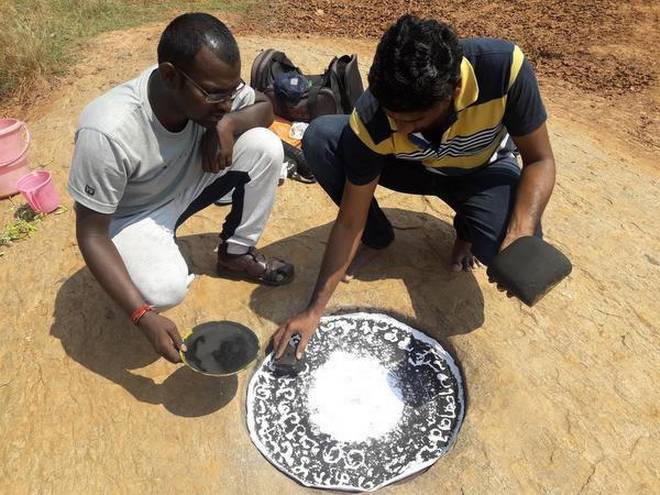Monthly Archives: February 2018
25
24
23
How a recent archaeological discovery throws light on the history of Tamil script

A team of amateur archaeologists discovered an oil press belonging to 10th century C.E. near Andipatti with a Tamil script. It is one of the earliest Tamil inscriptions to be found in this region.
When R. Udhayakumar a research scholar of Government Arts College, Melur got a call from Tamil teacher Balamurugan from Andipatti about an age-old stone structure that resembles a grinder, he did not take it seriously. But when he along with his friend C. Pandeeswaran, who is also a research scholar from Madurai Kamaraj University, visited the spot he came to know that it was not a grinder but a ‘chekku’ (oil press, used to extract oil).
“When I went there I could locate the oil press neatly carved on the rocky bed of a wild brook, which now runs dry,” says Udhayakumar. “The place is very near to the revenue department office in Andipatti and many villagers say that they had seen water flowing through when there was flood some years ago,” he says.
The team took estampage of the inscription and it was brought to C. Santhalingam, secretary, Pandyanadu Centre for Historical Research, to decipher. “Based on the inscription, the oil press belongs to 10th century CE. It is written in Tamil script and says that the oil press was installed by one Kudiyaan Thevan for common purpose. Also, the inscription throws light on the village and its geographical location. The place is inscribed as ‘Thenmutta Naatu Kannimangalam’. Probably, there should have been many Kannimangalams and this one is located in Thenmutta Naadu, a geographical unit Kings followed in those periods. Places in and around Andipatti region were called as Thenmutta Naadu and there are references,” says Santhalingam.
Though discovering an oil press is nothing new in these parts as the team identified similar one in Chitharevu near Periyakulam six months ago. What made the discovery significant is the Tamil script on it. Earlier ones had Vattezhuthu script. “King Raja Raja Chola I ruled Pandya Kingdom during 10th century CE and he introduced Tamil script here as he was quite adept in it. Also, he did not know to read Vattezhuthu. Hence, he recorded all his documents in Tamil script and encouraged the people to learn the same. The king had even translated Vattezhuthu script to Tamil script evident from the Kutralanathar Temple inscriptions in Courtallam. Comparatively, Tamil script was easy to learn than Vattezhuthu and public patronage grew that saw the decline of Vattezhuthu. Gradually, Tamil script gained prominence,” he says.
Tamil script was widely practiced and popularised by Pallavas who had inscribed on the door jambs of sanctum santorum of temples in Thanjavur. “In fact, it was Pallavas who helped Cholas learn the script. Most of the inscriptions after Chola rule in Pandya kingdom are in Tamil script,”
Early inscriptions found in Pandya Kingdom are in Tamil Brahmi and Vattezhuthu scripts. Even in Irukkandurai, a medieval period port city in Radhapuram Taluk in Tirunelveli, which was discovered by Santhalingam and his team last year, there are 25 inscriptions. Of them, only three belonged to early Pandyas and they are in Vattezhuthu whereas the rest are in Tamil script and they talk about the prowess of Rajendra Chola I.
The oil press found in Andipatti goes into history as the symbol of transition from Vattezhuthu to Tamil script.
source: http://www.thehindu.com / The Hindu / Home> Society / by T. Saravanan / Madurai – February 21st, 2018